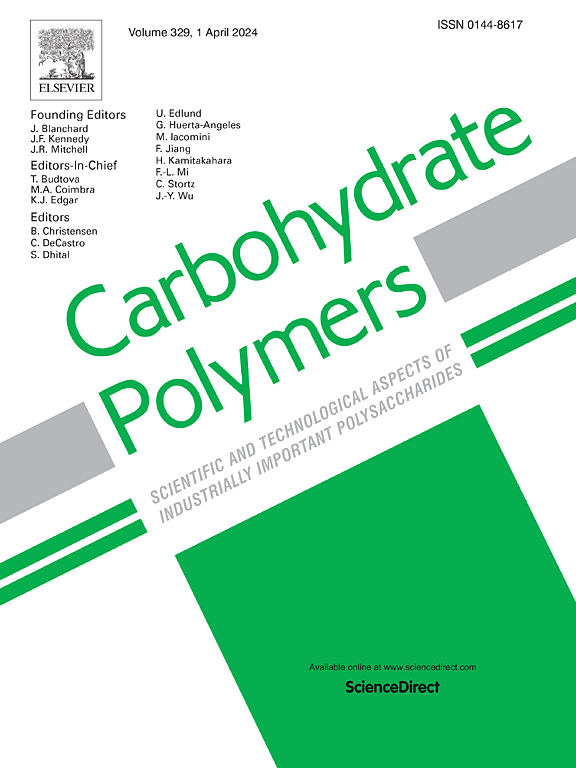甲基丙烯酸淀粉与甲基丙烯酸壳聚糖的混合生物链接使复杂组织支架的高精度3D打印成为可能
IF 10.7
1区 化学
Q1 CHEMISTRY, APPLIED
引用次数: 0
摘要
淀粉基凝胶因其生物安全性、生物相容性和生物可降解性而成为3d打印细胞支架的有前途的生物墨水。然而,它们的广泛采用受到成形性不足和自持性差的阻碍。在这里,我们介绍了一种创新的淀粉为主的水凝胶体系,通过普通玉米淀粉和壳聚糖的双甲基丙烯酸基化实现,使生物可降解细胞支架的制造成为可能。虽然单独甲基丙烯酸淀粉(取代度为0.013)在UV辅助下的打印精度不足,但优化后的10:1(淀粉/壳聚糖,w/w)甲基丙烯酸壳聚糖(取代度为0.27)与UV交联后的3D打印成形性和精度显著提高。流变学分析表明,甲基丙烯酸淀粉与甲基丙烯酸壳聚糖混合可以降低流动应力τf,在保持剪切减薄性能的同时提高印刷性能。10%甘油的掺入增强了生物大分子的相容性,流变学结果和SEM的均匀微观结构证明了这一点,使复杂结构的高保真打印成为可能。uv固化支架具有可调的抗压强度(150-200 kPa)和变形率(50 - 60%),平衡了力学顺应性和组织安全性。该材料的亲水性表面(接触角:30-60°)支持强大的细胞粘附,而体外实验证实了出色的生物相容性(96%的细胞存活率),并在α-淀粉酶/溶菌酶溶液中控制生物降解。这项工作建立了淀粉作为生物墨水的主要基质,推进了生物医学领域的可持续、高精度3D打印。本文章由计算机程序翻译,如有差异,请以英文原文为准。

Hybrid bioink of methyacrylated starch with minimal methacrylated chitosan enables high-precision 3D printing for complex tissue scaffolds
Starch-based gels represent promising bioinks for 3D-printed cell scaffolds due to their biosafety, biocompatibility, and biodegradability. However, their widespread adoption has been hindered by inadequate formability and poor self-supporting properties. Here, we introduce an innovative starch-dominated hydrogel system achieved through dual methacrylation of normal corn starch and chitosan, enabling the fabrication of biodegradable cell scaffolds. While methacrylated starch alone (substitution degree: 0.013) exhibited insufficient printing accuracy even with UV assistance, the optimized 10:1 (starch/chitosan, w/w) blend of methacrylated chitosan (substitution degree: 0.27) demonstrated dramatically enhanced 3D printing formability and precision when combined with UV crosslinking. Rheological analysis demonstrated that blending methacrylated starch with methacrylated chitosan reduced flow stress (τf), improving printability while retaining shear-thinning behavior. Incorporation of 10 % glycerol enhanced biomacromolecular compatibility, as evidenced by rheological results and homogenous microstructures in SEM, enabling high-fidelity printing of intricate architectures. UV-cured scaffolds exhibited tunable compressive strength (150–200 kPa) and deformation rate (50–60 %), balancing mechanical compliance with tissue safety. The material's hydrophilic surface (contact angle: 30–60°) supported robust cell adhesion, while in vitro assays confirmed exceptional biocompatibility (96 % cell viability) and controlled biodegradation in α-amylase/lysozyme solutions. This work establishes starch as a primary matrix for bioinks, advancing sustainable, high-precision 3D printing in biomedicine.
求助全文
通过发布文献求助,成功后即可免费获取论文全文。
去求助
来源期刊

Carbohydrate Polymers
化学-高分子科学
CiteScore
22.40
自引率
8.00%
发文量
1286
审稿时长
47 days
期刊介绍:
Carbohydrate Polymers stands as a prominent journal in the glycoscience field, dedicated to exploring and harnessing the potential of polysaccharides with applications spanning bioenergy, bioplastics, biomaterials, biorefining, chemistry, drug delivery, food, health, nanotechnology, packaging, paper, pharmaceuticals, medicine, oil recovery, textiles, tissue engineering, wood, and various aspects of glycoscience.
The journal emphasizes the central role of well-characterized carbohydrate polymers, highlighting their significance as the primary focus rather than a peripheral topic. Each paper must prominently feature at least one named carbohydrate polymer, evident in both citation and title, with a commitment to innovative research that advances scientific knowledge.
 求助内容:
求助内容: 应助结果提醒方式:
应助结果提醒方式:


